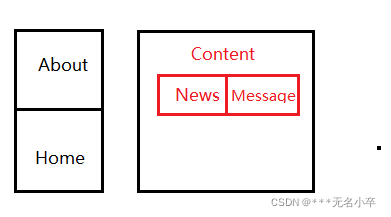Vue学习笔记|路由、详细、入门
目录
1.什么是路由
2.前端路由和后端路由的区别
3.路由应用实例
4.嵌套路由
5.路由传参
6. 路由缓存方式
7. router相关函数
8. 组件不被销毁
9.路由守卫
10. 路由器的两种工作模式
11. 注意点
1.什么是路由
路由是一组映射关系(key-value)
key是路径,value可能是function或者component
2.前端路由和后端路由的区别
2.1 后端路由
1)value是function,用于处理客户端提交的请求
2)工作过程:服务器接收到一个请求时,根据请求路径找到匹配的函数来处理请求,返回响应数据
2.2 前端路由
1)value时component,用于展示页面内容
2)工作过程:当浏览器的路径发生变化,对应的组件就会显示
3.路由应用实例
如图,左边是导航栏,右边是内容区。
当点击About,在内容区切换About组件的内容,
当点击Home,在内容区切换Home组件的内容,
3.1 下载router包
vue2:npm i router@3
vue3:npm i router@4
3.2 配置路由信息
假设有两个组件,对应两个路由
import VueRouter from 'vue-router'
import About from '../components/About'
import Home from '../components/Home'
export default new VueRouter({
routes:[
{
path:'/about',
component:About
},
{
path:'/home',
component:Home
}
]
})3.3 引入路由
在main.js文件引入路由
import VueRouter from 'vue-router'
import router from './router/index'
Vue.use(VueRouter)
Vue.config.productionTip = false
new Vue({
render: h => h(App),
router:router
}).$mount('#app')3.4 路由的使用
其中,
About
Home
4.嵌套路由
如图,当点击Home时,在Home组件中,又添加了News和Message路由,只需要在路由配置文件中,添加二级路由。
{
path:'/home',
component:Home,
children:[
{
path:'message',
component:Message
},
{
path:'news',
component:News
}
]
}5.路由传参
5.1 params传递参数
5.1.1 配置路由,声明接收params参数
在path后使用“:变量名”作为占位符接收params参数
children:[
{
name:'detail',
path:'detail/:id/:title',
component:Detail,
}
]5.1.2 传递参数(二选一即可)
字符串传递参数
{{i.title}}
对象传递参数
注意:对象传递参数只能使用name进行路由跳转,不能使用path
{{i.title}} 5.1.3 参数接收
{{$route.params.id}}}
{{$route.params.title}}}
5.2 query传递参数
5.2.1传递参数(二选一即可)
字符串传递参数
如图,可以向路由传递id和title,注意,变量需要在${}中写,整个字符串需要加上` `
{{i.title}}
对象传递参数
{{i.title}}
5.2.2 参数的接收
参数保存在每个组件的$route.query中,可以通过以下获得组件传递的参数
{{$route.query.id}}}
{{$route.query.title}}}
5.3 props传递参数
5.2.1对象写法
传递key和value
children:[
{
name:'detail',
path:'detail',
component:Detail,
props:{
id:'001',
title:'我是标题'
}
}
]detail组件接收参数
props:['id','title'],detail组件使用参数
{{id}}
{{title}}
5.2.2 props为布尔值(结合params使用)
children:[
{
name:'detail',
path:'detail',
component:Detail,
props:true
}
]意义:将路由收到的所有params参数通过props传给Detail组件
接收参数和使用参数与5.2.1一致
5.2.3 函数写法(结合query使用)
children:[
{
name:'detail',
path:'detail',
component:Detail,
props($route){
return{
id:$route.query.id,
title:$route.query.title
}
}
}
]
接收参数和使用参数与5.2.1一致
6. 路由缓存方式
1. push方式
每改变路由,都会将最新的路由放入路由栈中,作为栈顶
2. replace方式
每改变路由,都会替换路由栈中已有的路由
7. router相关函数
使用除了
使用函数this.$router.push 和 函数this.$router.replace可以改变路由,两者的区别见第六条。
methods:{
pushShow(i){
this.$router.push({
name:'detail',
query:{
id:i.id,
title:i.title
}
})
},
replaceShow(i){
this.$router.replace({
name:'detail',
query:{
id:i.id,
title:i.title
}
})
},
}使用路由进行前进后退
this.$router.back() : 后退一步
this.$router.forward() : 前进一步
this.$router.go(2) : 前进两步
back(){
this.$router.back();
},
forward(){
this.$router.forward();
},
go(){
this.$router.go(2);
}8. 组件不被销毁
在router-view外边加入
9.路由守卫
路由守卫的作用:前端判断是否操作者有权限使用该路由,若没有权限,则拦截路由
9.1全局前置路由守卫
初始化时候被调用,每次路由切换前被调用
当需要跳转的路径为/home/message 或者 /home/news时,判断是否有权限,并进行相关的操作
router.beforeEach((to, from, next )=>{
if(to.path==='/home/message' || to.path==='/home/news'){
if(判断是否有权限){
//有权限
next();
}else{
//没有权限相关操作
}
}else{
next();
}
})9.2全局后置路由守卫
初始化时候被调用,每次路由切换后被调用
如下,在每次路由切换后,更改页面的标题
router.afterEach((to)=>{
document.title=to.meta.title || '霍格沃兹';
})其中,meta是配置在路由信息中的一个属性,meta是固定的一个key,不可修改
{
name:'about',
path:'/about',
component:About,
meta:{
title:'关于'
}
}9.3 独享路由守卫(只有前置,没有后置)
独享前置路由守卫写在路由配置中,如下图所示。
{
name:'news',
path:'news',
component:News,
meta:{
title:'新闻',
isAuth:true
},
beforeEnter:(to,from,next)=>{
if(to.meta.isAuth){
if(localStorage.getItem('school')=='霍格沃兹'){
next();
}else {
alert('学校不对,无权查看');
}
}else{
next();
}
}
}9.4 组件路由守卫
故名思意,组件路由守卫写在组件内,当进入组件前和离开组件的时候会调用组件路由守卫
beforeRouteEnter(to,from,next){
//进入组件前可以进行权限控制
},
beforeRouteLeave(to,from,next){
//离开组件后可以进行数据的处理等等操作
}10. 路由器的两种工作模式
1)hash模式
在vue框架中,路由默认使用hash模式
特征:路径中带有#,hash值不会带给服务器
2)history模式
特质:history模式的路径不带#,且路径会带到服务器,并向服务器请求资源
使用history模式在服务器会出现问题:请求路径找不到,因为这是前端部分写的路径,服务器并不能识别。
解决:
安装插件
npm i connect-history-api-fallback
在服务器中使用插件,注意:要在引用静态资源之前使用插件
const express=require('express')
const history=require('connect-history-api-fallback')
const app=express();
app.use(history())
app.use(express.static(__dirname+'/static'))
app.get('/person',(req,resp)=>{
resp.send({
name:'小僵',
age: 18
})
})11. 注意点
1)通过切换,被隐藏的组件,默认被销毁
2)整个组件只有一个router,可以通过组件的$router获取
3)每个组件都有$route属性,存路由信息,this.$route可以获取路由信息
4)二级路由path不需要加/

